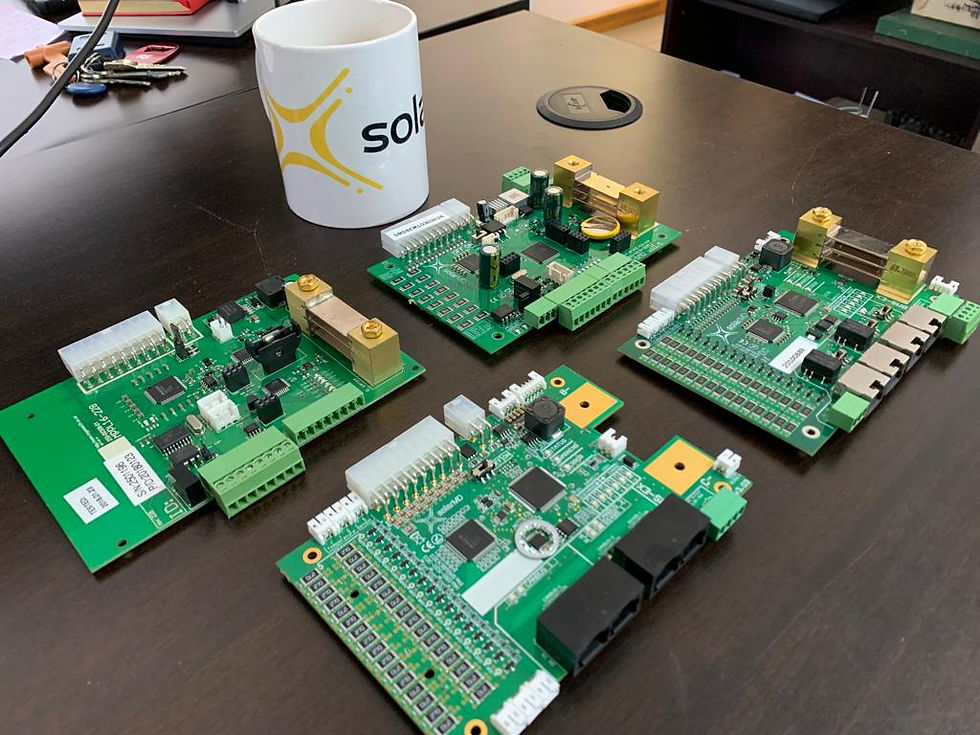What is a Battery Management System?
- tiaan.botha

- Dec 13, 2022
- 3 min read
Updated: Dec 21, 2022
To people who are not interested in the renewable energy space, a Battery Management System, more commonly known as a BMS, can sometimes sound like a supercomputer. In most discussions I’ve had regarding this topic, it’s met with a dumbfounded facial expression with the response being, “but it’s just a battery?”. Further elaboration is me explaining all about a smartphone and how the lithium-ion battery installed also has its own BMS.

Solar MD's various versions of the in-house designed and developed Battery Management Systems. The BMS-PL, the BMS-EM & the BMS-EX passively balancing 7 cells at a time.
In energy storage, the term battery refers to the entire pack of multiple cells. 3.2V LiFePO4 cells are placed in series connection up to a certain voltage, 12V(13V), 24V(26V) or 48V(51.2V). The reason for a higher voltage is because the transfer of electrodes occurs at a higher voltage than other battery types. Inverters are designed with an operating voltage range as wide as 38-66V DC. This is a topic for another day.
The rechargeable battery pack is monitored and controlled by the BMS in various factors such as for the battery to operate within the battery’s safe operating area and consist of the following:
Voltage
Current
Temperature control
State of Charge
State of Health
The critical information is processed by the BMS and will allow for the avoidance of the critical cases such as a decrease in battery capacity or battery life and will substantially decrease the risk of a potential fire in the case of unsafe operating practices.
A well designed and developed BMS stops the over/under voltage before it’s a problem for battery life. Over Cell voltage will bring the system to a sleep state as an alert for you to discharge the system as well as intervene by checking that the entire system is operating within safe operating practices. Once the system has been efficiently discharged, the BMS will start balancing the cells in order to retain full capacity of the battery.
When a battery is considered, general thought goes into the amount of energy that can be stored in a battery. It is however very important to understand what the allowable charge/discharge current is. This is essentially how quickly the battery can be charged with the values typically rated in amps with higher values indicating faster charging speeds and lower values, slower charging times. A C-rating is generally indicated on a datasheet of a battery to determine the allowable charging current of a battery.
At Solar MD, temperature control of a LiFePO4 battery is very important. Keeping the battery at a steady 22’C within its optimal operational 20-25’C temperatures greatly improving life cycle guarantee. The acceptable operational temperature of the battery is 0’C-50’C and operating the battery outside of these parameters will lead to degradation of performance and irreversible damages.
The SoC or State of Charge is the measurement of the amount of energy available in a battery and is indicated in a percentage value at a specific time. The higher the percentage will indicate a fully charged battery with lower percentages indicating a discharged value. This will be indicated in different colors on a LED with green indicating a full charge, orange or amber indicating 50% discharged battery and red indicating a completely discharged battery.
The SoH or State of Health is a value reflecting a value relative to the original capacity of the battery at the time of manufacturing. Contributing factors to the state of health of the battery is based on all of the points discussed already.

The Solar MD in-house designed and developed BMS-EX based in the original BMS-PL and BMS-EM
LiFePO4 batteries are very powerful batteries but the battery’s reaction to misuse can be very dangerous. It is therefore very important to make use of a highly advanced and developed Battery Management System to prevent any serious use cases and for the battery to be operational within safe operating practices.



Comments